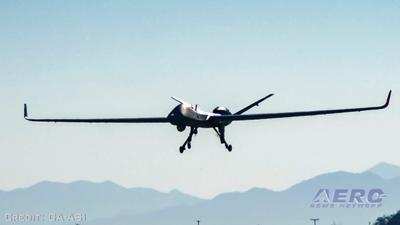Wed, Feb 07, 2024
Lean, Mean Testing Process Assists USAF & GA-ASI on Product Development
General Atomics has capped a series of test flights with the U.S. Air Force Special Operations Command to continue development on its Adaptive Airborne Enterprise concept.

A trio of notable demonstrations proved out a few elements of the project, with the first being a practical application of simultaneous control from a single control station. That test saw one team remotely command a triplet of MQ-9A aircraft from a single government-owned AFSOC RPA Control Suite. The ARCS system is shaping up to be the cornerstone of their MQ-9 test regimen, with an aim to one day use it to control the MQ-9A, the MQ-9B aircraft, and a family of small drones.
The second demo sent an MQ-9A on a firing test using an Altius 600. The 27-lb munition sports a loitering time of more than 4 hours, allowing for a good amount of standoff capability for a passing UAV. The third demo consisted of SATCOM launch & recovery operations, where a trio of MQ-0As were launched from portable control stations before being handed off to a single ARCS unit. Control was then handed off between the ARCS system and the original ground control suite, with the aircraft performing satellite-controlled landings afterwards.
“We have established a great partnership with AFSOC,” said David R. Alexander, president of GA-ASI. “We know our RPA will be a key building block for AFSOC to achieve its Adaptive Airborne Enterprise vision.”
General Atomics has continued to be a common sight around the AFSOC water cooler, thanks to its supportive attitude and convenient product portfolio. The brand has used the MQ-9B to forego some of the typical bureaucracy involved in acquiring developmental aircraft, allowing AFSOC to prototype quicker and more efficiently. That works for both sides, overall - the Air Force gets a leaner, more custom-tailored product and General Atomics gets solid development data as it builds products that warfighters actually want.
“These demonstrations were what we needed to really start to make A2E a reality,” said AFSOC Colonel Trey Olman. “This was the first time we were able to demonstrate control of multiple RPAs from a single workstation, which is important in reducing manpower requirements.”
More News
He Attempted To Restart The Engine Three Times. On The Third Restart Attempt, He Noticed That Flames Were Coming Out From The Right Wing Near The Fuel Cap Analysis: The pilot repor>[...]
Make Sure You NEVER Miss A New Story From Aero-News Network Do you ever feel like you never see posts from a certain person or page on Facebook or Instagram? Here’s how you c>[...]
From 2009 (YouTube Edition): Leading Air Show Performers Give Their Best Advice for Newcomers On December 6th through December 9th, the Paris Las Vegas Hotel hosted over 1,500 air >[...]
Aero Linx: NASA ASRS ASRS captures confidential reports, analyzes the resulting aviation safety data, and disseminates vital information to the aviation community. The ASRS is an i>[...]
“For our inaugural Pylon Racing Seminar in Roswell, we were thrilled to certify 60 pilots across our six closed-course pylon race classes. Not only did this year’s PRS >[...]
 NTSB Final Report: Rutan Long-EZ
NTSB Final Report: Rutan Long-EZ ANN FAQ: Turn On Post Notifications
ANN FAQ: Turn On Post Notifications Classic Aero-TV: ICAS Perspectives - Advice for New Air Show Performers
Classic Aero-TV: ICAS Perspectives - Advice for New Air Show Performers ANN's Daily Aero-Linx (06.28.25)
ANN's Daily Aero-Linx (06.28.25) Aero-News: Quote of the Day (06.28.25)
Aero-News: Quote of the Day (06.28.25)



